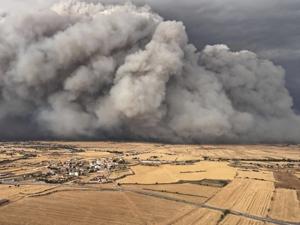BARCELONA, Spain — A devastating wildfire fueled by an intense heat wave has claimed the lives of two farmers in Spain as parts of Europe grapple with soaring temperatures. The blaze, which erupted late Tuesday in Lleida province, was brought under control with the aid of a timely rainstorm, officials reported on Wednesday.
The fire, which created a massive plume of ash and smoke reaching 14,000 meters (45,000 feet), was the largest recorded by firefighters in Catalonia, Spain’s northeastern region. At its peak, the wildfire spread at a speed of 28 kilometers per hour (17 miles per hour), marking it as one of the fastest-moving fires in Europe.
Tragic Loss and Swift Response
Catalan regional president Salvador Illa confirmed the deaths of the two victims, identified as a farmer and his worker, in a social media post late Tuesday. They were found near the village of Coscó in La Segarra county, apparently caught by the flames while attempting to escape.
Two firefighters sustained injuries and were treated at a local hospital. Despite the challenges, more than 500 firefighters were deployed, and the situation was stabilized with the help of rainstorms, which “quickly changed the situation,” according to the firefighting team.
Impact on Agriculture and Infrastructure
The wildfire ravaged approximately 6,500 hectares (16,000 acres) of mostly agricultural land, destroying fields of grains and cereals. Additionally, it incinerated at least three old farmhouses and several other farm buildings before being declared under control early Wednesday.
Authorities issued emergency alerts to residents via smartphones, instructing 14,000 people to remain indoors. This order was lifted once the fire was contained.
Heat Wave Intensifies Across Europe
The heat wave, which has set record high temperatures for June in Spain and Portugal, continues to pose challenges. Temperatures in the Lleida region were forecasted to reach 39 degrees Celsius (102 degrees Fahrenheit) on Wednesday.
“It will be a difficult day due to the high temperatures, and until we get past the hottest part of the afternoon, we will have to be on our guard,” Illa stated.
Spain’s national weather service reported that the average temperature for June, 23.6 degrees Celsius (74 degrees Fahrenheit), was a new record, surpassing the average temperatures for July and August.
Except for the northern Atlantic coast, Spain remains on high alert for extreme temperatures and wildfire risks. In Malaga, the Red Cross has established a “climate refuge” to provide air-conditioned relief and social interaction for residents.
Climate Change and Broader Implications
The European Center for Medium-Range Weather Forecasts is closely monitoring these abnormal temperatures, which experts link to climate change. The World Meteorological Organization notes that more than two-thirds of Europe’s most severe heat waves since 1950 have occurred since 2000.
Meanwhile, France’s national weather agency has placed four departments under red alert, with temperatures exceeding 40 degrees Celsius (104 degrees Fahrenheit). The Eiffel Tower in Paris remains closed for safety reasons.
Italy faces similar challenges, with heat alerts issued for 17 cities. The surge in air conditioning usage is straining the electric grid, causing blackouts in areas like Florence’s historic center. The Italian labor ministry is working on protocols to protect outdoor workers from heat exposure following a construction worker’s death in Bologna.
In Switzerland, efforts to prevent further environmental stress led to the shutdown of one reactor at the Beznau nuclear power plant, as the Aare River’s temperature needed to be controlled to protect local wildlife.
As Europe continues to battle these extreme conditions, the focus remains on mitigating immediate risks and addressing the long-term impacts of climate change.
 Tragic Loss: The Lives and Dreams of Four Slain Idaho Students
Tragic Loss: The Lives and Dreams of Four Slain Idaho Students North Korea to Send 30,000 Troops to Support Russia in Ukraine Conflict
North Korea to Send 30,000 Troops to Support Russia in Ukraine Conflict Rusted Car Discovery May Solve 15-Year-Old Cold Case on Long Island
Rusted Car Discovery May Solve 15-Year-Old Cold Case on Long Island UK Bonds Plummet Amid Political Uncertainty Over Finance Minister
UK Bonds Plummet Amid Political Uncertainty Over Finance Minister AP’s Top Photos of the Day: A Glimpse into Global Events
AP’s Top Photos of the Day: A Glimpse into Global Events